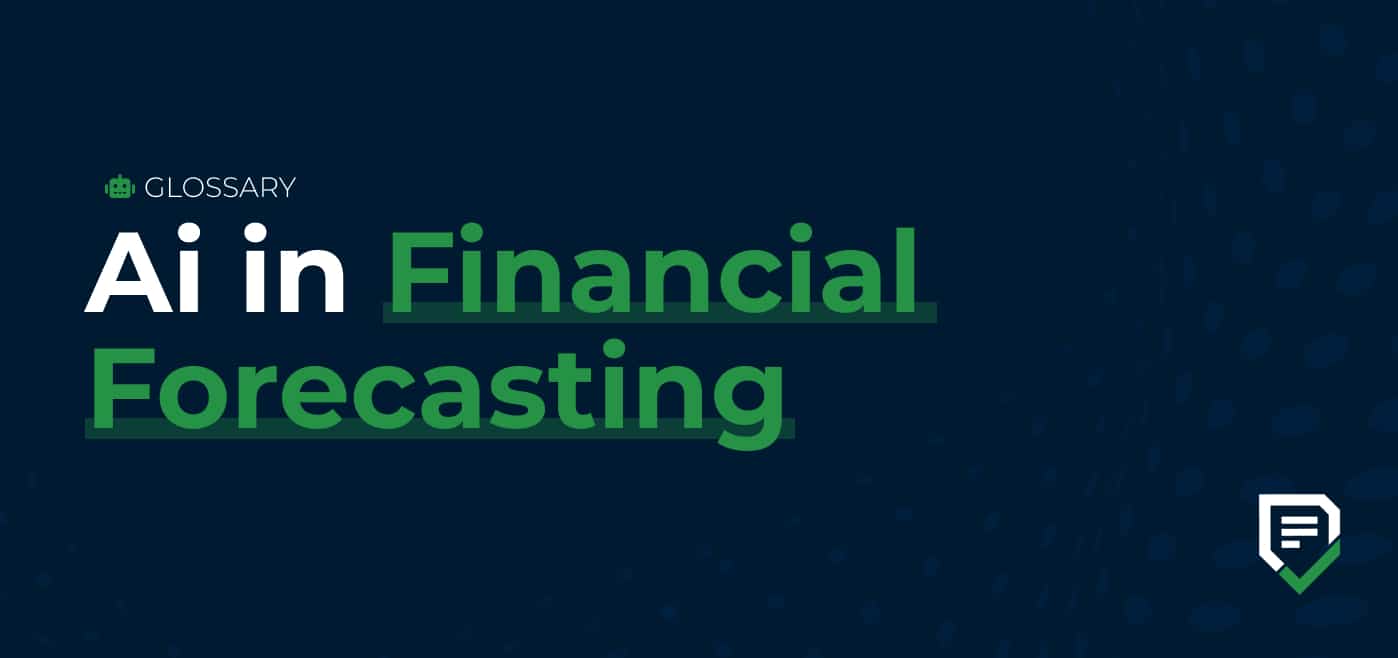Financial forecasting helps businesses analyze trends, predict future patterns, and allocate resources effectively. However, traditional manual methods can be inefficient, slow, and prone to errors.
Thanks to recent technological advancements, particularly ai in accounting, businesses can now overcome these challenges. AI-powered forecasting empowers you to make data-driven financial decisions for clients.
What is AI in Financial Forecasting?
AI in financial forecasting refers to the use of advanced algorithms, machine learning models, and data analytics to analyze historical financial data, identify patterns, and predict future economic outcomes.
According to a Gartner prediction, 80% of large enterprise finance teams will use internal AI platforms by 2026. The reason is apparent: Unlike traditional forecasting methods, artificial intelligence can process vast amounts of data in real-time and enable quicker responses to market changes. As such, firms that leverage AI for financial forecasting can:
- Improve cash flow predictions
- Detecting subtle predictive patterns
- Optimize budget allocations
- Free finance teams to focus on more strategic roles
Traditional vs. AI-Driven Financial Forecasting
Traditional financial forecasting relies heavily on historical data and basic statistical methods. While these approaches can yield valuable insights, they often lack accuracy when faced with large datasets or rapidly changing economic conditions.
In contrast, AI-driven financial forecasting uses sophisticated algorithms to process vast amounts of data, adapt to emerging trends, and deliver highly accurate predictions. It helps reduce uncertainty, allowing you to anticipate risks, plan for growth, and allocate resources more effectively.
Key Areas Where AI is Transforming Financial Forecasting
Here are various areas where you can apply artificial intelligence in financial forecasting.
Revenue Forecasting
AI’s predictive analytics can analyze past sales data, market trends, and seasonal patterns. This insight enables you to help clients predict future revenue, plan, and make informed financial decisions more accurately.
Expense Optimization
AI accounting tools can analyze spending patterns and inefficiencies, providing insight that allows you to create realistic budgets, cut costs, and allocate resources more effectively.
Cash Flow Management
Maintaining healthy cash flow is critical for any business to thrive. AI can analyze cash inflows and outflows and provide insights into financial health.
By tracking income and expenses in real-time, you can help your clients predict fluctuations and take proactive measures to maintain financial stability.
Market Trends and Sentiment Analysis
AI can also analyze market trends and customer sentiment for deeper financial insights. It can evaluate economic indicators, social media discussions, and industry news to help businesses foresee shifts in consumer behavior and market conditions.
With this information, you can adjust financial strategies and stay on top of changing economic conditions.
Data Collection and Integration
Accurate financial forecasts require access to high-quality data from multiple sources. AI streamlines this process by gathering financial data from accounting software, CRM systems, market reports, and other relevant platforms. Integrating these datasets gives you a more complete and accurate picture of their financial health.
Investment & Portfolio Management
AI-powered portfolio management tools can automate asset allocation, optimize investment strategies, and provide real-time insights to maximize returns and minimize risks.
Importance of Artificial Intelligence in Forecasting
Greater Efficiency and Productivity
At Vena’s 2023 Excelerate Summit, 44.5% of finance professionals said improved productivity and efficiency in financial operations were their most appealing AI benefits, and it’s easy to see why. It enables you to work faster, smarter, and more efficiently.
Faster Data Processing and Analysis
AI-driven forecasting can process vast amounts of data in a fraction of the time it would take traditional methods. This swift data processing allows you to generate forecasts quickly and enables your accounting firm to make timely, data-informed decisions that can positively impact business outcomes.
Ability to Analyze Large Datasets
Today’s businesses produce enormous amounts of data from various sources, including transactions, social media, market trends, and economic indicators. AI can efficiently analyze these large datasets and extract relevant insights to enhance financial forecasts. Big Data in accounting is an example.
Improved Scenario Planning
AI takes financial forecasting to the next level by helping you evaluate a wider range of potential financial scenarios. It can analyze multiple variables, such as market fluctuations, economic changes, and internal factors, and predict how they might impact financial performance.
Increased Accuracy and Reduced Errors
Traditional forecasting methods often rely on subjective assumptions and limited datasets, leading to errors. AI can minimize these biases by using objective data analysis and statistical modeling to identify intricate patterns that human analysts may miss.

This information leads to more precise predictions, reduced forecasting errors, better resource allocation, and overall financial stability. In an IBM study, half of the companies that use AI for forecasting decreased their overall forecast error by 20%.
Enhanced Risk Management
AI can identify potential financial risks that might otherwise go unnoticed. It analyzes historical data and identifies patterns of volatility or instability. With this information, you can anticipate and mitigate potential threats.
How to Implement AI in Your Financial Forecasting Process
Integrating AI into your forecasting workflow increases speed, accuracy, and efficiency. Here are steps to help you get started.
1. Define Clear Objectives
Start by identifying forecasting areas that will benefit most from AI. Speak to your team members to gather more insights about their challenges. Then, establish measurable goals you want to achieve with AI, such as enhancing forecast accuracy, improving data consolidation, or reducing processing time.
2. Choose the Appropriate AI Tool
Research and select AI-driven software that aligns with your firm’s needs and budget. Here are factors to consider when choosing an AI forecasting tool:
- Offer essential features like predictive analytics, machine learning, and scenario modeling.
- Integrates well with your existing systems
- Can scale as your firm grows
- User-friendly, especially for non-technical users
3. Train AI models with Historical Data
Feed historical financial data into AI models and relevant external data sources to help them recognize patterns and trends. More high-quality data leads to accurate predictions.
4. Test and Validate AI Models
Before fully integrating AI into your financial forecasting process, you must test its accuracy. Compare AI-generated forecasts with past financial data to see how well the model predicts outcomes. Identify any discrepancies and refine the model accordingly.
5. Integrate AI with Existing Workflows
Connect the system with your existing ERP and financial software using APIs. This integration will allow data to flow smoothly across systems, enabling you to access real-time insights and make more informed decisions about budgeting, investment strategies, and risk management.
6. Invest in Training and Adoption
Empower your team with the knowledge and skills to use AI forecasting software effectively. Provide hands-on training, real-world examples, and continuous support. Keep communication open for questions, feedback, and suggestions to encourage adoption.
7. Monitor Performance and Adjust
AI systems evolve and improve with time, but regular monitoring is key to maintaining accuracy. Continuously assess performance, compare financial forecasts with actual outcomes, and gather user feedback to identify areas for improvement. Adjust models to enhance reliability and stay aligned with real-world financial trends.
Limitations of AI Financial Forecasting
While AI can enhance financial forecasting, many firms still struggle to implement it. Here are common challenges they face.
Data Quality and Integrity Issues
AI predictions are only as good as the data they process. The forecasts can be misleading if the input data is incomplete, inconsistent, or outdated.
That’s why financial experts must prioritize data accuracy and integrity. Rather than relying solely on AI, combine AI-driven insights with human expertise to validate results and make well-informed decisions.
Security Risks
AI-driven forecasting relies on vast amounts of sensitive financial data, making it a potential target for cyberattacks. Hackers may attempt to steal data, manipulate predictions, or disrupt operations. To mitigate these risks, prioritize robust cybersecurity measures such as encryption, multi-factor authentication, and continuous monitoring to safeguard financial information.
Challenges with Systems Integration
Integrating AI into existing financial systems isn’t always seamless. Compatibility issues between platforms can lead to data silos or inefficiencies. Assess system compatibility and work closely with IT specialists to streamline the integration process for a smoother transition.
Regulatory and Compliance Considerations
AI-driven forecasting must align with financial regulations and data protection laws. Businesses handling sensitive financial data must ensure compliance with industry standards and legal requirements, such as GDPR. Regular audits and updates to AI systems can help maintain compliance and protect client data.
What Does the Future Hold for AI Financial Forecasting
- Hyper-Personalized and Real-Time Forecasting: AI will enable highly personalized financial forecasts tailored to clients’ unique business needs.
- Enhanced Scenario Planning: AI will facilitate the creation of increasingly complex and realistic financial scenarios that incorporate a wider range of variables and potential risks.
- Integration of Alternative Data Sources: AI will leverage a broader range of alternative data sources, such as social media sentiment, satellite imagery, and geolocation data. These insights will improve forecast accuracy and give you a more comprehensive view of market trends and potential disruptions.
- Explainable AI (XAI) and Transparency: As AI evolves, businesses emphasize explainability and transparency. A Deloitte survey found that 50% of business leaders see the lack of explainability and transparency in AI decisions as a major barrier to scaling AI projects. This is where Explainable AI (XAI) is necessary. XAI techniques help financial analysts see how AI models make predictions, making decision-making more transparent.
Final Thoughts
AI isn’t here to replace accountants and financial analysts, but to enhance their expertise. Automating routine tasks allows you to focus on higher-level strategic decisions, deeper data analysis, and stronger client relationships.
Firms that embrace AI gain powerful insights into cash flow management, budgeting, and investment strategies. More accurate financial forecasting allows you to provide tailored, data-driven advice that strengthens client trust and confidence.
Want to streamline your accounting and financial workflows? Use Financial Cents to keep everything organized.

